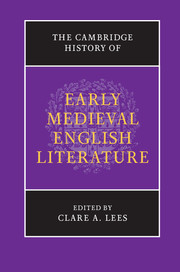Book contents
- Frontmatter
- Contents
- List of Illustrations
- List of Contributors
- Acknowledgements
- List of Abbreviations
- Introduction: literature in Britain and Ireland to 1150
- I WORD, SCRIPT AND IMAGE
- II EARLY ENGLISH LITERATURE
- 7 Across borders: Anglo-Saxon England and the Germanic world
- 8 English literature in the ninth century
- 9 The writing of history in the early Middle Ages: the Anglo-Saxon Chronicle in context
- 10 The literary languages of Old English: words, styles, voices
- 11 Old English poetic form: genre, style, prosody
- 12 Beowulf: a poem in our time
- 13 Old English lyrics: a poetics of experience
- 14 Literature in pieces: female sanctity and the relics of early women’s writing
- 15 Saintly lives: friendship, kinship, gender and sexuality
- 16 Sacred history and Old English religious poetry
- 17 Performing Christianity: liturgical and devotional writing
- 18 Riddles, wonder and responsiveness in Anglo-Saxon literature
- III LATIN LEARNING AND THE LITERARY VERNACULARS
- Bibliography
- Index of manuscripts
- Index
7 - Across borders: Anglo-Saxon England and the Germanic world
from II - EARLY ENGLISH LITERATURE
Published online by Cambridge University Press: 05 February 2013
- Frontmatter
- Contents
- List of Illustrations
- List of Contributors
- Acknowledgements
- List of Abbreviations
- Introduction: literature in Britain and Ireland to 1150
- I WORD, SCRIPT AND IMAGE
- II EARLY ENGLISH LITERATURE
- 7 Across borders: Anglo-Saxon England and the Germanic world
- 8 English literature in the ninth century
- 9 The writing of history in the early Middle Ages: the Anglo-Saxon Chronicle in context
- 10 The literary languages of Old English: words, styles, voices
- 11 Old English poetic form: genre, style, prosody
- 12 Beowulf: a poem in our time
- 13 Old English lyrics: a poetics of experience
- 14 Literature in pieces: female sanctity and the relics of early women’s writing
- 15 Saintly lives: friendship, kinship, gender and sexuality
- 16 Sacred history and Old English religious poetry
- 17 Performing Christianity: liturgical and devotional writing
- 18 Riddles, wonder and responsiveness in Anglo-Saxon literature
- III LATIN LEARNING AND THE LITERARY VERNACULARS
- Bibliography
- Index of manuscripts
- Index
Summary
Anglo-Saxons were tied to the continent in many ways. Above all, Germania was their cradle: Bede tells a detailed story about their Germanic roots; to Boniface, these roots were an incentive for his missionary zeal; for the narrator of the voyages of Ohthere and Wulfstan, a fact to be mentioned with awe. Artefacts betray the Germanic origin of the settlers who arrived in Britain from 400 onwards. By 600, the culture of the ruling elite shows a much wider horizon: the gifts that accompanied the ship burial at Sutton Hoo hail from as distant places as Byzantium and Egypt. The conversion drew the Anglo-Saxons into a cultural world in which the Mediterranean and Judaeo-Christian element was dominant but which afforded a legitimate place for the Germanic world from which the Anglo-Saxons originated and to which they remained tied not only linguistically. The seventh-century Franks Casket emits this identity in both image and word (see Chapter 3 above): visually, Weland the Smith flanks the adoration of the Magi, and Old English text in runic characters accompanies Latin text in roman script. The Anglo-Saxons so much belonged to the ‘old world’ that Beowulf, though written in England and in English, is set completely in the (north) Germanic world. This chapter, then, charts relations between continental Germanic cultures in and beyond the British Isles from Tacitus and Bede to such poems as Waldere, Widsith, Finnsburh, the Leiden Riddle, the Hildebrandslied, Heliand and Genesis, and examines the cultural and aesthetic work of texts such as these. The chapter also invites a meditation on the powerful cultural traffic between the Germanic world (Francia, Frisia, Saxony) and the English.
Borders and identities
Borders presuppose the presence of spaces, territories and domains which have elements in common that differ from what lies outside. Such spaces can be physical and virtual. Hadrian’s Wall, for example, was erected to demarcate visibly, solidly and menacingly the northern limit of the Romans’ sway over Britain from around 125. However, in Anglo-Saxon England this monument of Roman imperialism had lost its original delimiting (and controlling) function – borders are clearly by no means permanently fixed but prove to be prone to change over time.
- Type
- Chapter
- Information
- The Cambridge History of Early Medieval English Literature , pp. 185 - 208Publisher: Cambridge University PressPrint publication year: 2012
- 1
- Cited by



